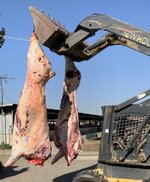Jake Larsen
WKR
So…
You don’t get drt with bow. But we know tissue destruction is what kills.
if big heavy hits bone or does not exit, then all that energy is dumped into the animal. This causes tissue damage and cns disruption.
Also do to size and muscle a fragmenting bullet with 10-12” of penetration might not reach vitals. Severing blood vessels is what kills
I agree with form. For most animals on the planet a 223 with tmk or eldm creates massive trauma which easily and humanely harvest the animal
I’m not sure I disagree with Form either. I’m just looking for clarity in the thinking/theory. One way to do critical thinking is to push the idea to its outer limit, and see at what point/if it falls apart.
I 100% agree that tipped match bullets kill effectively. I personally don’t care for the wound channel they create, but not because it doesn’t work. It’s the massive tissue damage that turns me off. I prefer a controlled expansion bullet for my game animals from a meat care standpoint.
Seems to me the outer limit is with big, heavy skinned dangerous game when your life is on the line.
From what I’ve seen, big heavy, slow/solid bullets don’t do near as much tissue damage. No “holes you can stick your fist through” so why would we choose them to kill In this scenario, if ALL that matters is bleeding/tissue damage? I think there may be some other physics going on. Is it the energy created from the mass/speed creating a shock wave that’s lights out on the CNS? Is it purely penetration, getting that bullet into the brain(tissue damage)? When people talk about “knock down power” I think they’re probably referring to one or a combination of these things.
Sent from my iPhone using Tapatalk
Last edited:


